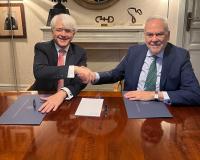
1. Hechos.
La petición de decisión prejudicial fue presentada en el marco de un litigio entre Rosa dels Vents Assessoria, S.L. (“Rosa dels Vents”) y U Hostels Albergues Juveniles, S.L. (“U Hostels”), en relación con la acción ejercitada por Rosa dels Vents por la infracción de sus marcas prioritarias mediante la utilización por U Hostels de una marca registrada posterior sobre la representación estilizada del denominativo “UH”.
Frente a la acción ejercitada por Rosa dels Vents, U Hostels alegó que Rosa dels Vents no había ejercitado la correspondiente acción de nulidad contra su registro de marca. Ante ello, y a la vista de las contradicciones existentes entre la jurisprudencia del TS y la del TJ (sentencia Fédération Cynologique Internationale) el Juzgado de lo Mercantil nº 3 de Madrid decidió suspender el procedimiento y plantear la siguiente cuestión prejudicial:
“¿Debe interpretarse el artículo 5.1 de la Directiva [2008/95] en el sentido de que el derecho exclusivo del titular de una marca de prohibir a cualquier tercero el uso en el tráfico económico de signos idénticos o similares a su marca se extiende al tercero titular de una marca posterior, sin que sea necesaria una declaración previa de nulidad de esta última marca?”.
2. Pronunciamientos.
En su Auto, el TJ comienza por analizar la sentencia dictada en el caso Fédération Cynologique Internationale (C-561/11) y tras exponer las consideraciones que sirvieron de base a la interpretación del TJ del artículo 9.1 del Reglamento de Marca Comunitaria, afirma que las mismas resultan pertinentes a la hora de interpretar el alcance, tal y como ha sido armonizado por la Directiva 2008/95, del derecho exclusivo conferido por las marcas que hayan sido objeto de registro en un Estado miembro o en la Oficina Benelux de la propiedad intelectual o que hayan sido objeto de un registro internacional que surta efectos en algún Estado miembro.
Tanto el artículo 9.1 del Reglamento como el artículo 5.1 de la Directiva confieren al titular de una marca registrada un derecho de exclusiva y lo habilitan para prohibir “a cualquier tercero”, sin su consentimiento, el uso en el tráfico económico de signos que puedan ser lesivos para su marca, sin distinguir si los terceros son titulares de una marca o no.
De acuerdo con el TJ, una normativa como el artículo 34.2 de la Ley de Marcas que prohíbe el uso a “los terceros” está redactada en términos análogos a los actos de la UE de que se trata y, por tanto, el órgano nacional debe aplicar dicho artículo de un modo que resulte conforme con el artículo 5.1 de la Directiva, tal y como ha sido interpretado por el TJ.
Además, el TJ entiende que del contenido del artículo 9 de la Directiva –análogo al artículo 54 del Reglamento- se deriva que, antes de que sobrevenga la caducidad por tolerancia que prevé, el titular de una marca está facultado tanto para solicitar la nulidad de una marca posterior como para oponerse al uso de la misma mediante una acción por infracción.
Finalmente, el TJ precisa que no hay ninguna disposición en la Directiva que limite el derecho exclusivo del titular de la marca en favor del tercero titular de una marca posterior.
Así las cosas, del artículo 5.1 de la Directiva se deduce que el titular de una marca debe disponer de la posibilidad de prohibir al titular de una marca posterior que haga uso de ella y ello en la medida en que las disposiciones de la Directiva deben interpretarse a la luz del principio de prioridad, en virtud del cual, la marca anterior prima sobre la marca posterior.
Por todo lo expuesto, el TJ responde a la cuestión planteada que el artículo 5.1 de la Directiva debe interpretarse en el sentido de que el derecho exclusivo del titular de una marca de prohibir a cualquier tercero el uso en el tráfico económico de signos idénticos o similares a su marca se extiende al tercero titular de una marca posterior, sin que sea necesaria una declaración previa de nulidad de esta última marca.
3. Comentario.
El Auto del TJ confirma la posición adoptada por el TS en su sentencia de 14 de octubre de 2014 (Denso), en la que el tribunal español se aparta del que venía siendo su criterio hasta la fecha por estar en contradicción con la doctrina sentada por el TJ en su sentencia en el asunto Fédération Cynologique Internationale.
(Fuente de la información: ANUARIO ELZABURU 2015, recopilatorio de comentarios de jurisprudencia europea en materia de Derecho de Propiedad Industrial e Intelectual que realiza Elzaburu).
Documento citado:
- Sentencia del Tribunal de Justicia (UE) Sala 1ª, S 21-2-2013, nº C-561/2011
- REGLAMENTO (CE) No 207/2009 DEL CONSEJO de 26 de febrero de 2009 sobre la marca comunitaria.
- DIRECTIVA 2008/95/CE DEL PARLAMENTO EUROPEO Y DEL CONSEJO de 22 de octubre de 2008 relativa a la aproximación de las legislaciones de los Estados miembros en materia de marcas
ENGLISH VERSION
The scope of the exclusive right conferred by national trademarks. Order of the Court of Justice of 10 March 2015, UH (C-491/14).
1. Background.
The reference for a preliminary ruling was made within the context of legal proceedings between Rosa dels Vents Assessoria, S.L. (“Rosa dels Vents”) and U Hostels Albergues Juveniles, S.L. (“U Hostels”) regarding action filed by Rosa dels Vents for infringement of its earlier trademarks through U Hostels’ use of a later trademark registration for a stylised presentation of the word mark “UH”.
In its defence statement against Rosa dels Vents’ action, U Hostels argued that Rosa dels Vents had not brought
“Should Article 5(1) of Directive 2008/95 be interpreted as meaning that the exclusive rights of the proprietor of a trademark to prevent all third parties from using, in the course of trade, signs which are identical with or similar to his trademark extends to a third-party proprietor of a later trademark, without the need for that latter mark to have been declared invalid beforehand?”
2. Findings.
In its Order, the CJ began by analysing the judgment that had been rendered in Fédération Cynologique Internationale (C-561/11). After setting out the considerations that served as a basis for the CJ’s interpretation of Art. 9(1) of the Community Trademark Regulation, it stated that they were relevant for interpreting the scope of the exclusive right conferred by trademarks that have been registered in a Member State or at the Benelux Office for Intellectual Property, or that have been registered under international arrangements which have effect in a Member State, as harmonised by Directive 2008/95.
Art. 9(1) of the Regulation and Art. 5(1) of the Directive both confer an exclusive right on the holder of a registered trademark, and they entitle that holder to prevent “any third party”, where consent has not been given, to use, in the course of trade, signs likely to have an adverse effect on their mark. No distinction is made as to whether or not those third parties are holders of a trademark.
According to the CJ, a provision such as Art. 34(2) of the Spanish Trademark Act, which prohibits “third parties” from use, is worded in a matter analogous to the EU measures at issue, and it is therefore for the national court to apply that article in a manner consistent with Art. 5(1) of the Directive, as interpreted by the CJ.
Moreover, the CJ considered it to be clear from the wording of Art. 9 of the Directive (analogous to Art. 54 of the Regulation) that until invalidity in consequence of acquiescence occurs, the holder of a trademark is authorised to request that the later mark be declared invalid or to oppose its use by means of infringement proceedings.
The CJ lastly points out that there is no provision of the Directive that limits the exclusive right of the trademark holder in favour of a third-party holder of a later mark.
It is therefore clear from the wording of Art. 5(1) of the Directive that the holder of a trademark must be able to prohibit its use by the holder of a later mark, insofar as the provisions of the Directive must be interpreted in light of the priority principle, according to which the earlier trademark takes priority over the later one.
On the basis of the above, the CJ answered the question referred to it in the sense that the exclusive right of the holder of a trademark to prevent all third parties from using, in the course of trade, signs identical with or similar to its trademark extends to a third-party holder of a later mark, without the need for that latter mark to have been declared invalid beforehand.
3. Remarks.
The CJ’s Order confirms the stance taken by the Spanish Supreme Court in its judgment of 14 October 2014 (Denso), in which the Spanish court departed from the criteria that it had followed previously on account of the fact that it contradicted the case-law established by the CJ in its judgment in Fédération Cynologique Internationale.
ElDerecho.com no comparte necesariamente ni se responsabiliza de las opiniones expresadas por los autores o colaboradores de esta publicación








